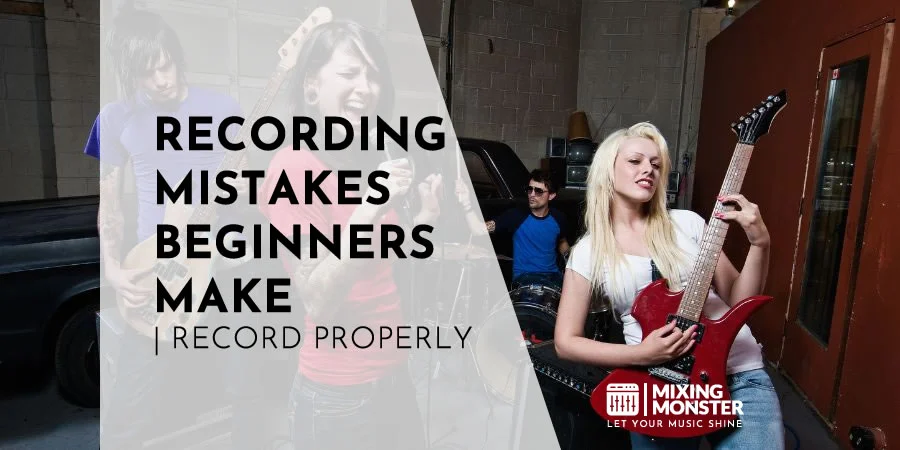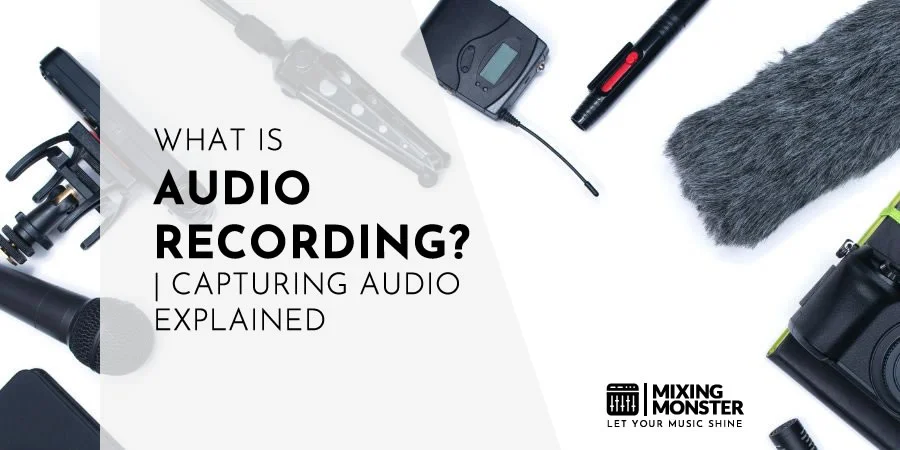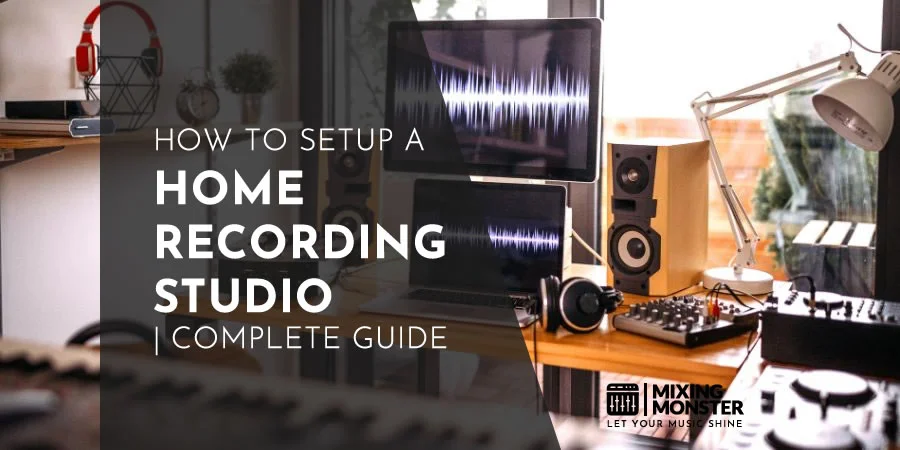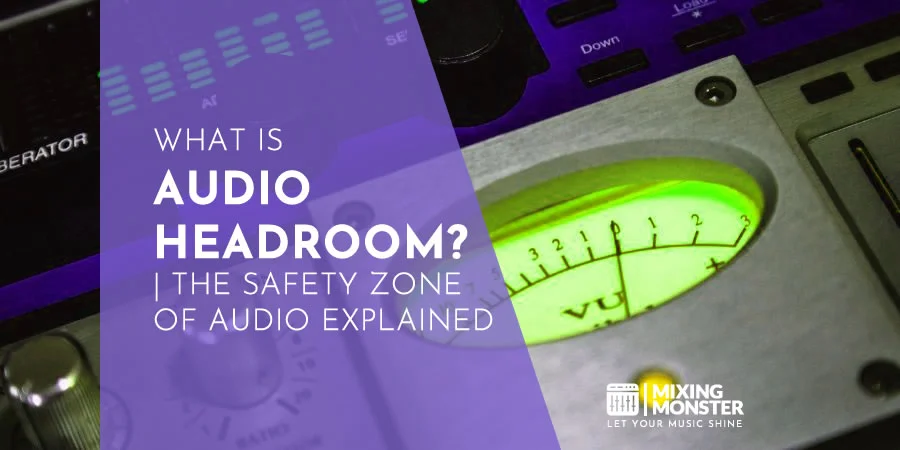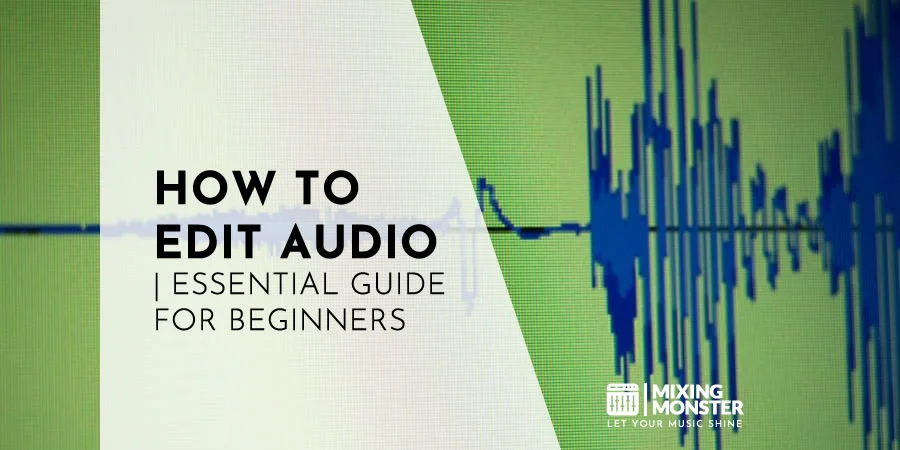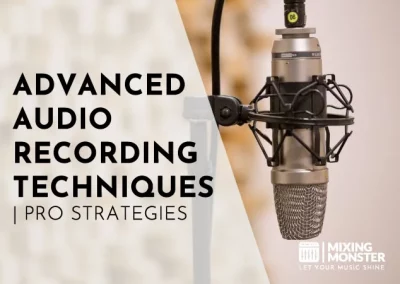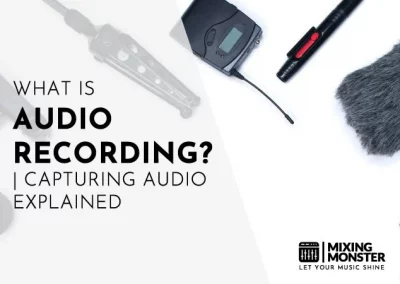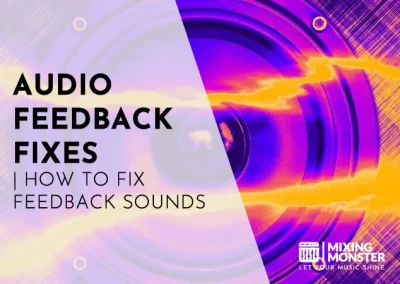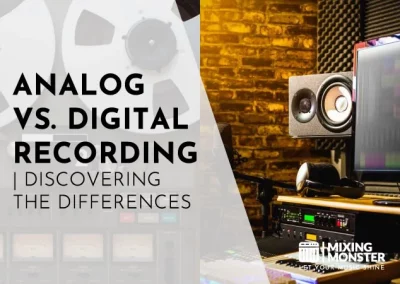Affiliate Disclaimer: We may earn a commission if you purchase through our links
Recording audio is an art; like any art, it’s easy for beginners to stumble upon common pitfalls. Let’s explore frequent recording mistakes that can turn your audio dreams into nightmares. This guide highlights these blunders and offers practical solutions to ensure your recordings shine, paving the way for successful editing, mixing, and mastering.
Recording mistakes significantly impact the quality of audio production. From improper hardware use to flawed recording environments, these errors can complicate subsequent audio processing phases like editing, mixing, and mastering, ultimately affecting the overall sound quality.
As we explore seven common recording mistakes, remember that each error is a learning opportunity. We aim to pinpoint what could go wrong and equip you with the knowledge and techniques to improve your recording skills.
Table Of Contents
1. Introduction: Recording The Right Way
2. Mistake 1: Inadequate Recording Environment
3. Mistake 2: Incorrect Recording Hardware Usage
4. Mistake 3: Overlooking Recording Software Settings
5. Mistake 4: Neglecting Recording Levels And Balancing
6. Mistake 5: Mismanaging Audio Layers And Tracks
7. Mistake 6: Poor Microphone Recording Technique
8. Mistake 7: Ignoring Acoustic Treatment In Audio Recording
9. Improving Your Recording Skills
10. FAQ

1. Introduction: Recording The Right Way
Understanding The Basics Of Audio Recording
Audio recording is both an art and a science, requiring a blend of technical knowledge and creative intuition. Recording is about capturing sound waves through microphones and converting them into a format listeners can eventually hear.
But it’s not just about hitting the record button; it’s about understanding how different microphones pick up sound, how acoustics work, and how to control various elements to get the desired result.
This guide will lay the foundation for beginners in audio recording, demystifying some technical aspects and emphasizing the importance of preparation, attention to detail, and a keen ear for quality.
Do you need an overview of audio recording? Here you go:
The Importance Of Avoiding Recording Mistakes
The path to a clean, professional-sounding recording often has potential things that could be improved. These can range from technical errors, like improper microphone placement or incorrect levels, to more nuanced issues, like not capturing the performance’s right emotional tone or energy.
Each mistake can diminish the quality of the final product, making the subsequent editing, mixing, and mastering stages more challenging and time-consuming.
Understanding the common pitfalls and how to avoid them is crucial. This article provides a roadmap for smoother, more successful recording sessions.
Common Recording Mistakes Vs. Solutions
Here is a brief overview of what we will cover in this article:
| Mistake | Consequences | Solutions |
| Inadequate Recording Environment | Poor audio quality, unwanted reverb, and noise | Implementing acoustic treatments, rearranging space |
| Incorrect Hardware Usage | Distorted or weak sound, lack of clarity | Choosing the right microphone, proper setup |
| Overlooking Software Settings | Latency issues, suboptimal sound quality | Correct configuration, regular software updates |
| Neglecting Levels and Balancing | Clipping, inaudible tracks, unbalanced mix | Monitoring levels, understanding headroom |
| Mismanaging Audio Layers/Tracks | Confusing mixes, phase issues | Organizing sessions, effective layering strategies |
| Poor Microphone Technique | Plosives, sibilance, inconsistent levels | Proper positioning, using pop filters |
| Ignoring Acoustic Treatment | Echoes, flutter, muddy recordings | Adding diffusers, bass traps, absorption panels |
How Audio Recording Mistakes Affect Later Production Stages
Recording is the first step in a longer journey of audio production. Mistakes at this stage can have a domino effect, causing problems that become magnified during editing, mixing, and, ultimately, mastering.
For instance, a recording with a lot of background noise might require extensive noise reduction later, which can degrade the audio quality. Or, a poorly captured vocal might need so much vocal tuning and pitch correction processing that it loses its natural feel.
Understanding these consequences is vital to appreciating why getting recording right from the start is critical.
2. Mistake 1: Inadequate Recording Environment
Identifying A Poor Recording Environment
The environment where you record can be as crucial as your equipment. An inadequate recording space can introduce unwanted reverb, echo, and noise, which can be challenging to remove later.
Identifying a poor recording environment involves understanding how sound interacts with the room. Hard surfaces reflect sound, creating echoes, while noisy surroundings (as well as the echoes or other instruments) can “bleed” into your recording.
Poor Recording Environment: Consequences On Audio Quality
An unsuitable recording environment for this purpose can significantly compromise the quality of your audio. Echoes and reverb can muddy your sound, making isolating your desired clean, direct signal difficult.
Background noise can distract from the main audio and make it less professional. Furthermore, an inadequate space can limit your ability to capture a performance’s full dynamic range and nuances.
Creating The Ideal Recording Environment
Crafting the ideal recording environment is more than finding a quiet room. It’s about understanding and manipulating the space to serve your recording needs.
This might involve adding acoustic treatment to control reflections and reverb, rearranging the room to minimize noise, or even choosing the right time of day to record when it’s quietest.
From simple, no-cost adjustments to more significant investments, it is inevitable to create a space that enhances audio quality rather than detracts from it.
Learn more about how to set up your home recording studio properly here:
3. Mistake 2: Incorrect Recording Hardware Usage
Selecting the proper recording hardware is a pivotal decision that can significantly impact the quality of your audio. Many beginners need to consider the specific needs of their project to avoid choosing equipment based on popularity or price alone.
Microphones, audio interfaces, and studio monitors are not one-size-fits-all tools. Each piece of equipment has unique characteristics and is suited for different environments and sound sources.
Common Missteps In Recording Hardware Selection
A common misstep is using a microphone ill-suited for the environment or the audio source. For instance, using a highly sensitive condenser microphone in an untreated room can lead to unwanted background noise and reverb in your recordings.
Similarly, choosing an audio interface without enough inputs and outputs or with poor-quality preamps can restrict your recording capabilities and affect the clarity and depth of your sound.
Feel free to check out this guide to find the perfect audio interface for your specific needs:
Hardware Impact On Instrument And Vocal Recording
The choice of hardware profoundly impacts the capture of instruments and vocals. The nuances of vocal performance or the depth of an acoustic instrument can be lost or misrepresented with improper hardware. A microphone that complements the artist’s voice range and timbre is crucial for vocals.
For instruments, understanding the sonic characteristics and the dynamic range is critical. For example, dynamic microphones are generally preferred for loud sound sources like drums, while condenser microphones are favored for capturing the detailed sound of acoustic guitars or pianos.
Tips For Proper Recording Hardware Utilization
To maximize the potential of your recording hardware, consider the following tips:
- Understand Your Needs:
Before purchasing, assess what you need based on your recording, where you’re recording, and your overall goals. - Room Acoustics:
Match your hardware to your environment. In less ideal spaces, dynamic microphones perform better. - Mic Techniques:
Learn and experiment with microphone placement and angles. Even a slight change can significantly affect the sound. - Check Compatibility:
Ensure your hardware components work well with your software. Misaligned gear can lead to issues like latency or poor sound quality. - Invest In Quality:
While you don’t need the most expensive gear, investing in a few key pieces of quality hardware can make a substantial difference. - Continuous Learning:
Stay informed about new techniques and technologies. The recording industry continually evolves, and staying updated can give you an edge.
By avoiding these common mistakes and following these tips, you can significantly enhance the quality of your recordings right from the start and ensure that your hardware serves your creative vision effectively.
4. Mistake 3: Overlooking Recording Software Settings
In the digital age, recording software (Digital Audio Workstations or DAWs) is a central component of the audio production process. While hardware captures the sound, software is where the magic of shaping and refining the audio happens.
However, beginners often need to pay more attention to configuring their DAW settings correctly, leading to many problems that can affect the entire production workflow.
Navigating Recording Software Complexities
DAWs come with a multitude of settings and options. From input levels to buffer size, each setting can affect the quality and efficiency of your recording session.
A common mistake is not setting the correct sample rate and bit depth, leading to a lower-quality recording or unnecessarily large audio files.
Another frequent oversight is not optimizing the buffer size, leading to latency issues that can disrupt the recording process and performance.
It all starts with choosing your digital audio workstation (DAW) of choice:
Recording Software Flaws: Effect On Editing And Mixing Phases
The implications of incorrect software settings extend beyond the recording phase. Editing and mixing can become significantly more challenging with poorly recorded tracks.
Issues like clipping, unwanted noise, and latency can be time-consuming to fix and can degrade the quality of the final product.
A disorganized DAW session with poorly labeled tracks and inefficient routing can also lead to errors during the mixing and mastering stages.
Optimizing Recording Software For Best Results
To get the most out of your recording software, consider the following strategies:
- Understand Your DAW:
Spend time learning the ins and outs of your software. Knowing its capabilities and settings can dramatically improve your workflow and recording quality. - Set Appropriate Levels:
Ensure your input levels are set correctly to avoid clipping or too low signals. Aim for a healthy signal level without hitting the red on your audio meters. - Choose The Right Sample Rate And Bit Depth:
For most projects, 24-bit depth and a 44.1kHz or 48kHz sample rate will provide high quality without excessive audio file sizes. - Organize Your Session:
Label tracks, use color coding, and maintain an orderly workflow. This practice will save time and reduce mistakes in later stages. - Regularly Update And Backup:
Keep your software up to date and always back up your sessions. Losing work due to a software glitch or a corrupted session can be devastating.
Paying close attention to your recording software settings and practices can ensure a smoother, more efficient recording process and a higher-quality end product.

5. Mistake 4: Neglecting Recording Levels And Balancing
Proper level setting and balance are the keystones of a sound recording. They ensure that each element of your audio is clear, distinct, and harmoniously fits within the overall mix.
However, beginners often need to pay more attention to this crucial step, either recording too loudly and causing distortion or losing detail in the noise too quietly.
Understanding Recording Levels And Balancing
Recording levels refer to the volume at which audio is captured. Too high, and you risk clipping and distortion; too low, and you’ll be fighting with background noise.
Balancing involves adjusting the levels of various tracks relative to each other to achieve a harmonious blend. Learning the technicalities of setting correct levels and the art of balancing is mandatory, and professionals approach these tasks meticulously to achieve pristine audio quality.
How Recording Levels Affect Mixing And Mastering
The levels at which you record directly impact the mixing and mastering stages. If a track is recorded too loudly and clips, no amount of mixing can undo the distortion. There are audio restoration processes, but the quality will never be pristine.
Similarly, a track recorded too quietly might require significant amplification, bringing up the noise floor and leading to a hissy or muddy mix. Understanding the long-term implications of your recording levels will help you make better decisions and save countless hours in post-production.
Learn more about how to balance levels in music production in this guide:
Achieving The Perfect Recording Balance
Achieving the perfect balance isn’t just about the technicalities of setting levels; it’s about understanding the dynamic interplay between different audio elements.
Creating a balanced mix in which every instrument is audible and the vocals are clear and focussed is an art. Pristine audio recordings always lay the foundation of a great mix!
When speaking about balancing levels, the concept of headroom and why leaving space in your mix is crucial for the later stages of music production is important:
What Is Audio Headroom? | The Safety Zone Of Audio Explained
6. Mistake 5: Mismanaging Audio Layers And Tracks
Proper audio layers and track management are crucial in creating a coherent and harmonious mix. When audio layers are mismanaged, it can lead to a chaotic and disorganized sound, making the editing and mixing process significantly more challenging.
Audio Layering And Track Management Basics
Any recording artist must understand the basics of audio layering and track management. Layering refers to the process of stacking multiple sound elements to create a fuller, more complex audio experience.
Each layer should have a distinct purpose and complement the other factors rather than compete with them. Effective track management ensures that each layer is clearly labeled, organized, and easily manipulated during editing and mixing.
Consequences Of Audio Layer Mismanagement In Editing
Mismanaged audio layers can lead to several problems in the editing phase, including phase issues, muddy mixes, and an overall lack of clarity and focus in the sound.
When layers are correctly aligned and organized, isolating and adjusting individual elements can be more accessible.
Moreover, poor track management can significantly increase the time and effort required to navigate and edit the session, detracting from the creative process.
Learn more about how to edit your recorded audio material in this article:
Strategies For Effective Audio Layering
To avoid the pitfalls of audio layering mismanagement:
- Employ consistent naming conventions, color-coding, and grouping similar tracks.
- Be judicious in your layering choices, focusing on quality over quantity.
- Use tools like panning, EQ, and volume adjustments to ensure each layer sits nicely in the mix without overpowering others.
- Make use of the top-down-mixing method.
- Regularly solo and mute tracks to assess their individual and collective impact on the overall sound.
7. Mistake 6: Poor Microphone Recording Technique
Microphone technique is critical in capturing clear and professional audio. Poor technique can lead to various problems, from plosives and sibilance to inconsistent levels, phase issues, and a lack of clarity.
Microphone Recording Basics: Do’s And Don’ts
Different microphones have different strengths, polar patterns, and ideal use cases. Understanding these can significantly affect the recording quality.
For instance, avoid speaking directly into the top of a condenser microphone to reduce the risk of plosives. Be mindful of the microphone’s proximity effect, which can overly enhance low frequencies when close to the source.
Microphone Impact On Vocal Clarity And Quality
The proper microphone technique can preserve the natural tone of the vocals or instruments and capture the intended emotional expression. Poor technique, conversely, can lead to a recording that feels flat, lifeless, or overly harsh.
Techniques like proper placement, understanding the microphone’s axis, and controlling the dynamics through physical distance can significantly enhance the recording’s clarity and quality.
Developing Effective Microphone Recording Techniques
Practice and experimentation are vital to developing effective microphone techniques. Record using different microphones, distances, and angles to understand their impact on the sound.
Learn to listen critically to the recordings, identifying issues (like phase cancellation) and adjustments needed. Over time, this will lead to an intuitive understanding of using the microphone best to capture the desired audio quality.
You can get better recordings from a single microphone you understand than several high-end mics you are unfamiliar with.
8. Mistake 7: Ignoring Acoustic Treatment In Audio Recording
Acoustic treatment is vital in achieving a clean and professional recording. Ignoring the acoustic properties of your recording space can lead to recordings compromised by echoes, reverb, and other unwanted sounds.
The Role Of Acoustics In Audio Recording
Sound interacts with every surface in your recording environment, with different materials absorbing, reflecting, or diffusing the sound in various ways.
Understanding these interactions can help you manipulate your space for better sound quality. For instance, hard surfaces reflect sound, creating echoes and reverb, while softer surfaces like carpets and curtains can help absorb unwanted noise.
A specific combination of sound diffusers and absorbers is needed in any recording room. These acoustic treatments need to be adjusted to the room itself.
Audio Acoustics: Effects On Audio Clarity And Depth
Inadequate acoustic treatment can lead to a flat or muddy sound, as the subtle nuances and details of the recording are lost amidst the ambient noise and reflections. Effective treatment, however, can enhance the clarity and depth of the recording, allowing each element to be distinctly heard and appreciated.
Implementing Basic Acoustic Treatments For Audio Recording
Simple acoustic treatments can include:
- Placing rugs or carpets on reflective floor surfaces.
- Using bookshelves filled with books to diffuse sound.
- Hanging heavy curtains over windows to reduce reflective surfaces.
- Placing sofas in the room functioning as a basic bass trap.
- Removing mirrors and glass surfaces.
Consider using specially designed panels and diffusers to control reverb and echoes for more advanced treatment. Even minor adjustments can significantly affect the quality of your recordings.
9. Improving Your Recording Skills
Summarizing Learning Points For Better Audio Recording
Review the critical mistakes discussed and their solutions (see table section 1). Remember the importance of a good recording environment, correctly understanding and using your equipment, and continually refining your techniques.
Keep a checklist or notes of these critical points to refer to before each recording session.
Checklist For A Successful Recording Session
- Preparation:
- Ensure all equipment is functioning correctly.
- Familiarize yourself with the recording software and hardware settings.
- Prepare and organize your recording space with the necessary acoustic treatment.
- During Recording:
- Monitor levels constantly to avoid clipping or recordings that are too low.
- Keep an eye on the physical and technical aspects of microphone placement.
- Take notes of any issues or particular takes you want to revisit during editing.
- Post-Recording:
- Label and organize your tracks.
- Make backups of your recordings.
- Take a moment to review the session and note any improvements for next time.
Experience And Adaptation In Audio Recording
As in most tasks: the more you record, the better you’ll become. Seek out opportunities to practice in different environments with various equipment and subjects. Be open to feedback and willing to adapt your techniques as you learn and grow.
Each recording is a learning opportunity, so reflect on what went well and what could be improved after each session.
Check out this comprehensive article on how to record music:
Next Steps In Your Audio Recording Journey
Consider further education, such as our online courses, workshops, or working with more experienced engineers and producers. Join communities where you can share experiences and learn from others.
Stay curious and keep up with new technologies and techniques that can enhance your recording skills!
Happy recording!
10. FAQ
- What Are the Most Common Recording Mistakes By Beginners?
Beginners often need help accounting for room acoustics, misusing microphones, setting improper levels, and overlooking the capabilities of their equipment. They might also rush into sessions with insufficient preparation or need to consider the needs of post-production processes. - How Do Recording Mistakes Impact The Mixing Process?
Recording mistakes typically introduce noise, distortion, and level inconsistencies, making the mixing process more about damage control than enhancement. Issues like phase cancellation and limited dynamic range can significantly restrict the creative scope during mixing, leading to a final product that might need to realize its full potential. - Can Poor Recording Techniques Be Fixed During Mastering?
Mastering is about refinement, not repair. It can’t resolve fundamental issues like pronounced distortion, clipping, or poor performance. While mastering can improve a good recording, it has limited capacity to improve a bad one, emphasizing the need for quality at the recording stage. - What Are Some Essential Tools For Quality Recording?
Quality recordings require a reliable microphone, an audio interface, monitoring tools like headphones and studio monitors, and a digital audio workstation for editing and mixing. Proper cables, stands, a pop filter for vocals, and room acoustic treatments are crucial to capturing the best possible sound. - How Important Is The Recording Environment In Music Production?
The recording environment profoundly influences the quality of sound capture. A well-treated space ensures clarity and purity of the recorded audio, free from unwanted echoes or noise. Poor environments can degrade the recording, adding reverb or noise that might be impossible to remove later, underscoring the environment’s critical role in achieving professional results.

